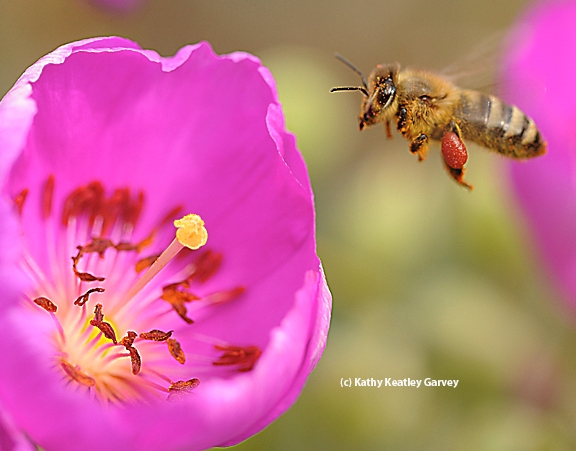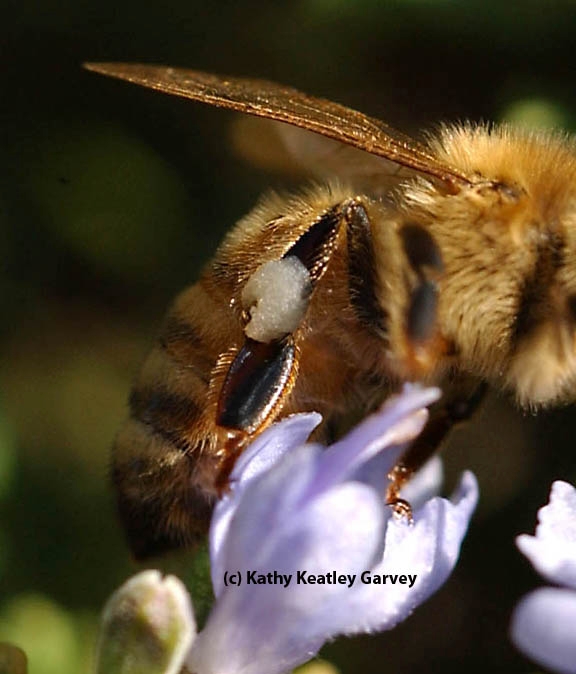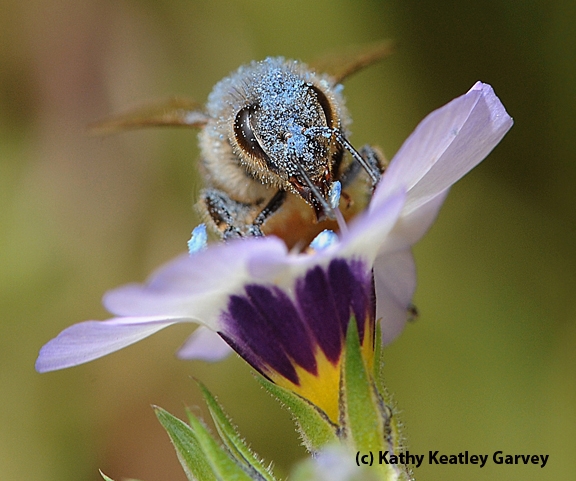- Author: Kathy Keatley Garvey
Christmas in May?
When it's in full bloom, the aptly named "tower of jewels," Echium wildpretii, which can tower as high as 10 feet, looks very much like a Christmas tree. Think of the brilliant red blossoms as red bells.
Native to the island of Tenerife, it belongs to the family Boraginaceae. It's a biennial, meaning that it takes two growing seasons to complete its life cycle. In the Vacaville, Calif., area, it blooms in its second year, around mid-April and diminishes by mid-May.
Honey bees love its nectar and pollen. And the pollen? It's blue, which is always a surprise when beekeepers open their hives. "Where did that blue come from?"
Scilla sibirica (wood squill) and Epilobium angustifolium (fireweed) also yield blue pollen as does Gilia tricolor (bird's eye). Borage pollen is a bluish-gray.
"The importance of pollen to the health and vigor of the honey bee colony cannot be overstated," writes emeritus entomology professor Norman Gary of the University of California, Davis, in his best-selling book, "Honey Bee Hobbyist, The Care and Keeping of Bees."
"Honey satisfies the bees' carbohydrate requirements, while all of the other nutrients---minerals, proteins, vitamins and fatty substances--are derived from pollen. Nurse bees consume large amounts of pollen, converting it into nutritious secretions that are fed to developing larvae. During an entire year, a typical bee colony gathers and consumes about 77 pounds of pollen."
Gary adds: "Pollen in the plant world is the equivalent of sperm in the animal world. Fertilization and growth of seeds depends upon the transfer of pollen from the male flower parts (anthers) to the receptive female parts (stigmas)."
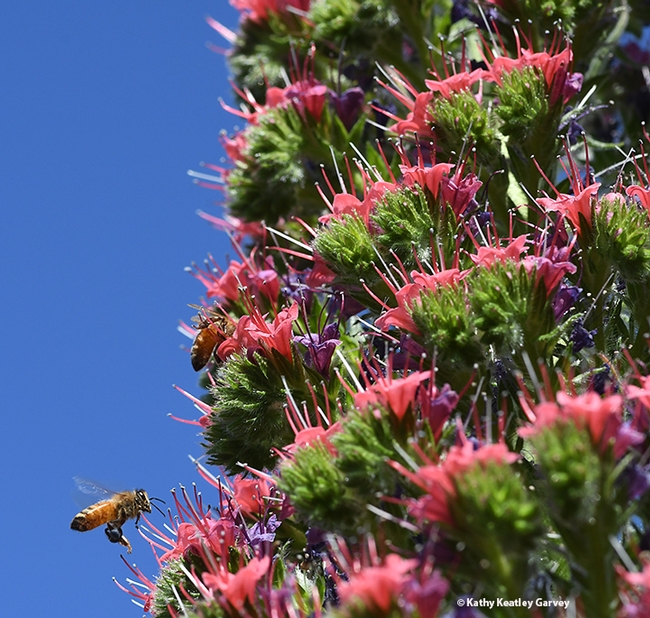
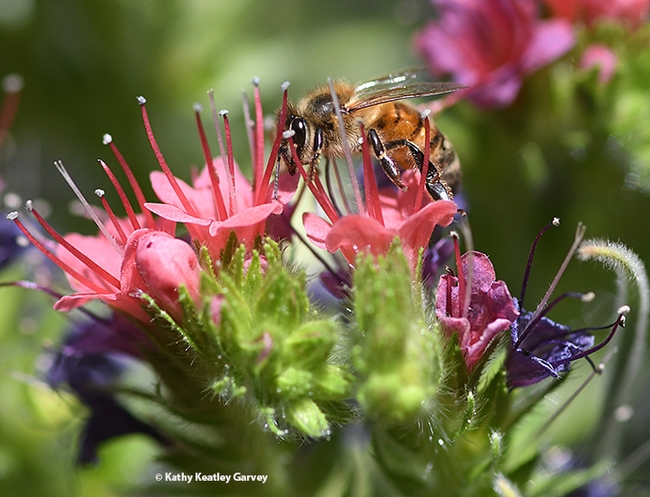
- Author: Kathy Keatley Garvey
The Echium wildpretii is commonly known as "The Tower of Jewels" but it ought to be known as "The Tower of Beauty."
That's especially when honey bees gather to collect the blue pollen and sip the sweet nectar.
Or when their wings glisten in the early morning sun.
Or when it's National Pollinator Week.
In our family, we call it "The Christmas Tree" due to two reasons: its height (it's as tall as a Christmas tree) and due to its spiked red blossoms, the color of Christmas.
The plant, in the family Boraginaceae, is biennial and it can reach 10 feet in height. You often see its purple-spiked cousin, the Pride of Madeira (Echium candicans) growing wild in Sonoma, along the roads to Bodega Bay.
The species is endemic to the island of Tenerife. There they call it "Tenerife bugloss."
Whatever you call the plant, it's good to see it racing up the popularity scale as gardeners seek it for their pollinator gardens. There's even a Facebook page, "We got an Echium through the winter."
Common question: "Anyone got seeds for sale?'
Echium wildpretii is that pretty.



- Author: Kathy Keatley Garvey
We have this tall plant in our back yard.
How tall is it?
Tall enough to give weather forecasts. (It's never caught “short” by a sudden storm.)
Tall enough to see over the neighbor's fence to find a missing ball.
Tall enough to be "the resident tall plant" in the garden (sort of like "the resident tall person" in the office who's asked to change the clocks when Daylight Savings Time ends or begins).
Tall enough to be called a “tower.”
Tall enough to be prohibited from taking a short course.
Tall enough to have strawberry longcake instead of strawberry shortcake.
Tall enough to dunk if it were an NBA player.
It's THAT tall.
The "tower of jewels," appropriately named, can tower up to 10 feet or so. It doesn't stop short of growing.
When in full bloom, it's covered with red blossoms that resemble a decorated Christmas tree. It's a member of the Boraginaceae family, andeven boasts a scientific name that has "pretty" in it. Sort of. It's Echium wildpretii and is endemic to the island of Tenerife.
What's really amazing is that the tower of jewels turns into a "tower of bees" when it blooms. It attracts honey bees (check out the blue pollen), carpenter bees and bumble bees, as well as hummingbirds, syrphid flies, and a few spiders.
How grand and glorious can it get? "Wildpretii" grand and glorious.


- Author: Kathy Keatley Garvey
It's the Fourth of July--a time to celebrate our nation's Independence Day.
Hurrah for the red, white and blue!
That also covers red, white and blue pollen collected by our honey bees.
If you look closely, you'll see their "patriotic" colors.
"The importance of pollen to the health and vigor of the honey bee colony cannot be overstated," writes emeritus entomology professor Norman Gary of the University of California, Davis, in his best-selling book, "Honey Bee Hobbyist, The Care and Keeping of Bees."
"Honey satisfies the bees' carbohydrate requirements, while all of the other nutrients---minerals, proteins, vitamins and fatty substances--are derived from pollen. Nurse bees consume large amounts of pollen, converting it into nutritious secretions that are fed to developing larvae. During an entire year, a typical bee colony gathers and consumes about 77 pounds of pollen."
Gary adds: "Pollen in the plant world is the equivalent of sperm in the animal world. Fertilization and growth of seeds depends upon the transfer of pollen from the male flower parts (anthers) to the receptive female parts (stigmas)."
Our honey bees are not native to America, but they've been here so long that many people think they are. European colonists brought them here to Jamestown Colony, Virginia, in 1622. Honey bees were established here before our forefathers signed the Declaration of Independence on July 4, 1776.
So, today, a time to celebrate the Fourth and a time to celebrate our honey bees, Apis mellifera.
